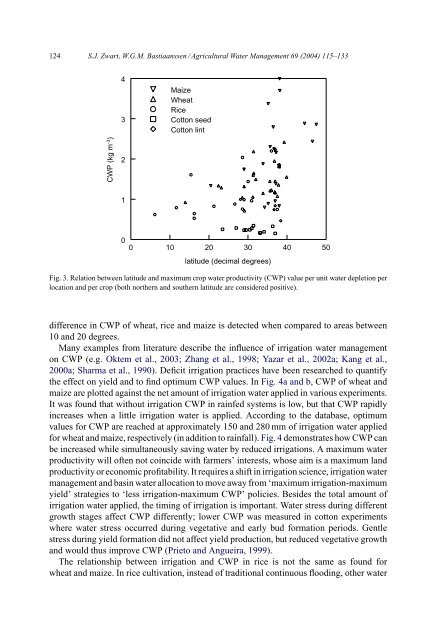Zwart_Bastiaanssen_2004_Review of measured crop water productivity values for irrigated wheat, rice,
Zwart_Bastiaanssen_2004_Review of measured crop water productivity values for irrigated wheat, rice,
Zwart_Bastiaanssen_2004_Review of measured crop water productivity values for irrigated wheat, rice,
You also want an ePaper? Increase the reach of your titles
YUMPU automatically turns print PDFs into web optimized ePapers that Google loves.
124 S.J. <strong>Zwart</strong>, W.G.M. <strong>Bastiaanssen</strong> / Agricultural Water Management 69 (<strong>2004</strong>) 115–133<br />
4<br />
3<br />
Maize<br />
Wheat<br />
Rice<br />
Cotton seed<br />
Cotton lint<br />
CWP (kg m -3 )<br />
2<br />
1<br />
0<br />
0 10 20 30 40 50<br />
latitude (decimal degrees)<br />
Fig. 3. Relation between latitude and maximum <strong>crop</strong> <strong>water</strong> <strong>productivity</strong> (CWP) value per unit <strong>water</strong> depletion per<br />
location and per <strong>crop</strong> (both northern and southern latitude are considered positive).<br />
difference in CWP <strong>of</strong> <strong>wheat</strong>, <strong>rice</strong> and maize is detected when compared to areas between<br />
10 and 20 degrees.<br />
Many examples from literature describe the influence <strong>of</strong> irrigation <strong>water</strong> management<br />
on CWP (e.g. Oktem et al., 2003; Zhang et al., 1998; Yazar et al., 2002a; Kang et al.,<br />
2000a; Sharma et al., 1990). Deficit irrigation practices have been researched to quantify<br />
the effect on yield and to find optimum CWP <strong>values</strong>. In Fig. 4a and b, CWP <strong>of</strong> <strong>wheat</strong> and<br />
maize are plotted against the net amount <strong>of</strong> irrigation <strong>water</strong> applied in various experiments.<br />
It was found that without irrigation CWP in rainfed systems is low, but that CWP rapidly<br />
increases when a little irrigation <strong>water</strong> is applied. According to the database, optimum<br />
<strong>values</strong> <strong>for</strong> CWP are reached at approximately 150 and 280 mm <strong>of</strong> irrigation <strong>water</strong> applied<br />
<strong>for</strong> <strong>wheat</strong> and maize, respectively (in addition to rainfall). Fig. 4 demonstrates how CWP can<br />
be increased while simultaneously saving <strong>water</strong> by reduced irrigations. A maximum <strong>water</strong><br />
<strong>productivity</strong> will <strong>of</strong>ten not coincide with farmers’ interests, whose aim is a maximum land<br />
<strong>productivity</strong> or economic pr<strong>of</strong>itability. It requires a shift in irrigation science, irrigation <strong>water</strong><br />
management and basin <strong>water</strong> allocation to move away from ‘maximum irrigation-maximum<br />
yield’ strategies to ‘less irrigation-maximum CWP’ policies. Besides the total amount <strong>of</strong><br />
irrigation <strong>water</strong> applied, the timing <strong>of</strong> irrigation is important. Water stress during different<br />
growth stages affect CWP differently; lower CWP was <strong>measured</strong> in cotton experiments<br />
where <strong>water</strong> stress occurred during vegetative and early bud <strong>for</strong>mation periods. Gentle<br />
stress during yield <strong>for</strong>mation did not affect yield production, but reduced vegetative growth<br />
and would thus improve CWP (Prieto and Angueira, 1999).<br />
The relationship between irrigation and CWP in <strong>rice</strong> is not the same as found <strong>for</strong><br />
<strong>wheat</strong> and maize. In <strong>rice</strong> cultivation, instead <strong>of</strong> traditional continuous flooding, other <strong>water</strong>
















